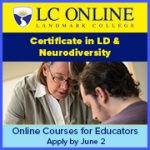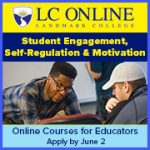 While the majority of a student’s program should be as closely aligned with the general education curriculum as possible, some accommodations and modifications may be necessary. Listed below are some suggested ways to aid students with specific learning disabilities (SLD) learn more effectively at home or at school. Selection from these and other possibilities must be based on the individual needs of each child.
While the majority of a student’s program should be as closely aligned with the general education curriculum as possible, some accommodations and modifications may be necessary. Listed below are some suggested ways to aid students with specific learning disabilities (SLD) learn more effectively at home or at school. Selection from these and other possibilities must be based on the individual needs of each child.
Information and ideas from a multidisciplinary team, including the parents and student, are important for developing an Individualized Education Program (IEP) that meets the unique needs of each student with learning disabilities. A carefully developed multidisciplinary approach will make classroom instruction meaningful for students.
-
- For some students who read slowly or with difficulty, a “read-along” technique may be used with taped texts and materials to allow learning of printed materials.
- For students with memory problems or difficulty taking notes, a fellow student might share notes; the student might tape the lesson; or the teacher might provide a copy of the lesson outline.
- For students who read below expected levels, educational videos and films or talking books can provide the general information that cannot be acquired from the printed page.
- For students with short term memory problems (e.g., understand math processes, but have short term memory problems that interfere with remembering math facts), a table of facts or a calculator could be provided.
- For students whose handwriting is slow, illegible or includes many reversed letters, a cassette recorder or a computer with word processing software could be used for written work or tests.
- For students who have difficulty with spelling, a “misspeller’s dictionary” or computerized spell checker can help make written materials readable.
- For students who have difficulty reading cursive, small, or crowded print, typed handouts, large print, or double spaced materials can help.
- To develop memory and listening skills, poetry, rhymes, songs, audio-taped materials and mnemonics may improve performance.
- To teach spelling, the teacher might use a multi-sensory approach that combines saying, spelling aloud, and writing words.
- Ways to improve vocabulary and comprehension can include a student-developed file of vocabulary words and the use of word webs and visual organizers to relate words and ideas heard or read on paper. A dictionary or thesaurus, suited to the child’s learning level, is also an excellent tool for building vocabulary, spelling and reading comprehension.
- For students who have difficulty organizing time, materials and information, a variety of approaches can be used, including:
- a quiet, uncluttered homework space
- alarm watch
- purchased texts that can be marked with a highlighter
- a homework assignment diary coordinated between home and school
- study skills instruction
- a personally-developed date-book or scheduler
- For students who copy inaccurately, but need written practice to solidify learning, changes that may help include: leaving a space directly under each word, phrase or sentence, or having handouts on the desk for those who can’t copy from the blackboard or take dictation accurately. For left-handed students, place the list of words at the right margin. For students whose writing is large, provide enlarged spaces for “fill in the blank” activities.
- For students who seem to process auditory information slowly (e.g., not fully understanding questions asked, recalling needed information, or forming an appropriate answer), be patient. Allow sufficient “wait-time for the answer or provide the questions in written form.
- Oral and written language should be taught together as much as possible. Illustrations in a book being read should be used to generate conversation, vocabulary and concepts that will relate to what is to be read. Material that is read can be translated into a verbal summary, a word web, a visual organizer, or a computer presentation.
- Students who find reading slow and difficult may benefit from supplementing the subject matter being read with video tapes, DVDs, captioned TV programs, or computer software.
More on Reading
Since reading is central to learning, children who do not learn to read by the second grade are likely to struggle with learning throughout their lives. Reading assessment should include skill levels in decoding, fluency and comprehension.
As children learn to read, they learn how spoken and written language relate to each other. Thus, the components of a reading program must also relate to one another, engage all children and meet their individual needs. Reading activities may include:
- Listening to good stories and books, appropriate to the child’s age, read aloud daily
- Language games that encourage identification of rhyming words and creation of rhymes
- Instruction and practice in phonemic awareness, alphabetic knowledge, alphabetic principles, decoding strategies, vocabulary acquisition, fluency and comprehension
- Additional reading instruction in a small group or tutoring setting
- Before/after school and summer school classes
Teaching Mathematics
Theories on mathematics disabilities view spatial visualization and verbal skills as critical. These two skill areas are important for anyone learning mathematics, but are especially important for students with learning disabilities. These areas should be heavily emphasized in the teaching and remediation of mathematical concepts and skills.
An individualized education program in mathematics would concentrate on developing concepts and skills within such strands as: numeration, geometry, measurement, collection and interpretation of data, estimation/mental computations, patterns and relations and word problems/applications. Concepts are best introduced with “hands-on” concrete materials. Knowing one-digit facts is important, but work with paper and pencil algorithms should not be emphasized, since calculations can be done with calculators if memory or sequencing is a problem.
Estimation strategies are often taught as mental computations skills are developed. Students should be encouraged to draw illustrations and representations whenever possible. They should consistently discuss, read and write as they solve more complex computational and word problems. For students with learning disabilities, confidence in the practical applications of mathematics to everyday life is also very important.


